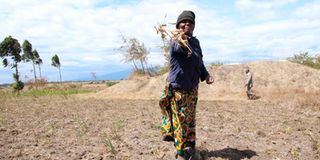Empower Asal women to boost food security

A woman inspects withered crops on her farm in Laikipia County. Millions of Kenyans living in arid and semi-arid lands grapple with famine due to drought that decimate crops and livestock.
What you need to know:
- According to Kenya Economic Outlook, as captured by the African Development Bank Group, the country’s real gross domestic product slowed to 5.5 per cent in 2022, partly because of drought.
- Kenya’s Economic Survey 2023 paints a grim picture of the agriculture sector, with its gross value added last year contracting by 1.6 per cent following a decline in performance in key subsectors.
The climate in arid and semi-arid regions continues to worsen, with prolonged droughts reducing their crop and livestock production.
With this comes starvation, the majority of those severely affected being women and children. So much has been said about Kenya’s food security situation.
Unfortunately, we are not getting any better as a country. Report after report has outlined ways through which we can solve this perennial crisis, with calls for massive investment in agriculture being a recurrent recommendation.
Can we crack the problem? Different parts of the country, especially arid and semi-arid land (Asal), are still mired in famine and starvation whenever drought strikes. This reeks of laxity on the part of the national and county governments.
According to Kenya Economic Outlook, as captured by the African Development Bank Group, the country’s real gross domestic product slowed to 5.5 per cent in 2022, partly because of drought. This is disheartening, as it raises questions on our preparedness and response measures, knowing all too well that such seasons will always come.
That in this day and age we still blame droughts for famine is difficult to understand. An excuse? Of course, yes. Many desert countries are doing way better in agriculture.
Kenya’s Economic Survey 2023 further paints a grim picture of the sector. Its gross value added last year contracted by 1.6 per cent following a decline in performance in key subsectors. Something is evidently wrong.
In many areas, the food crisis manifests itself in the stunting and wasting of children as malnutrition causes havoc. We cannot continue on the same path; it is high time we got it right.
The solution partly lies in empowering women to adopt climate-smart farming and building their resilience to climate shocks. This way, the country can protect water and food security, as well as livelihoods.
From a policy options perspective, we can fix the gender inequality in the agriculture sector. Women’s role remains crucial and equipping them would provide the silver bullet needed to drive us into the world of abundance.
Studies have shown that they, alongside children, suffer disproportionately when it comes to the fallout from climate change. They have lived it and won’t hesitate to find a way out of the maze if given a chance.
Skilling would help them understand their environment and adaptation measures badly needed to improve livelihoods, incomes and living conditions.
With knowledge of better farming methods, they will easily boost productivity. This will go a long way in fighting poverty and achieving food and nutritional security, as well as sustainable development.
Therefore, the national and county governments, with the support of development partners, have a duty to train women in regenerative and sustainable farming. This will also have positive environmental impacts. It works.
In Kitui County, a four-year Gender-Responsive Climate-Smart Agriculture Project is changing lives. It is a success story. The women are on a path to financial independence. They can now meet their family needs and expect their lives to continue changing for the better.





